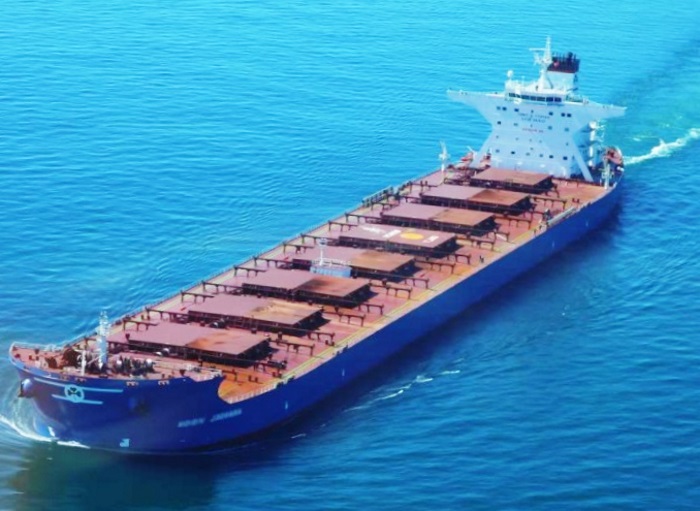Operation of sea-going bulk carriers involved numerous hazards. Careful planning and exercising due caution for all critical shipping-related issues is essential . This site provides quick details to the international shipping community on how to load and disperse bulk cargo. But, it should not go beyond the limits that are set by the classification society. It is essential to reduce the risk of stressing the vessel's structure and follow all safety precautions for the safety of sea travel. Our detailed pages address a variety of bulk carrier-related subjects that might be relevant to those working on board or ashore in the terminal.
General features of seagoing bulk carriers
Bulk carriers come with only one deck and comprise top-side tanks and hopper tanks. They are able to carry bulk cargo that is a single item. Any substance that is not gas or liquid, but is a solid bulk cargo, includes any material made up of mix of granules and/or mixtures, or any other material with an identical composition. This material is able to be loaded directly into the cargo area of a ship and doesn't require storage. Examples of dry cargo include grain, sugar and bulk ore. Bulk carrier, in its broadest sense can refer to any vessel specifically designed for carrying bulk cargo, including liquid cargo, or solid cargo. Tankers would also be included. In normal usage, however it is applied to vessels that are designed to carry bulky solid cargoes, which is typically grain and similar agricultural products as well as mineral products such as stone, coal, ore and more. and on some or all of the voyage legs. Peruse this dry bulk shipping info for more.
[img]https://www.wartsila.com/images/default-source/release-images/wartsila-scrubber-systems-to-clean-the-exhaust-from-two-new-japanese-bulk-carriers_image-courtesy-of-nyk-bp.tmb-tmb1366.jpg?Culture\u003den\u0026sfvrsn\u003d5efb9545_3[/img]
What Is A Bulk Transportation?
"A ship which is intended primarily to carry dry cargo in bulk, including such types as ore carriers and combination carriers"
The carrying weights vary from 3,000 tonnes up to 300,000.
Average speed of 12 15 knots
-Single deck ships, ie no tweendecks
-small to medium sized bulk carriers (carrying capacity of up to 40,000 tonnes) generally have cargo handling gear fitted, while larger vessels use dock-based facilities for loading and unloading
-Cargo holds are often large and free from obstructions. Large hatch sizes allow for easy loading/unloading.
-Ballast holds are a common element on bulk carriers. It can be utilized in ballast voyages to increase stability. Two or three additional holds could be allowed to partially ballast, but only when in port.
They are covered with single pull or hydraulic, or stacking (piggyback) style steel hatch covers
-Four types or ballast tanks
Sloping topside wing tanks
Sloping bottom side-wing tanks
Double bottom tanks
Peak and after peak water tanks.
Are you in search of bulk solid cargo? Any material other than liquid or gasoline comprised of a mixture or granules of smaller pieces, uniform in composition and loaded into cargo spaces. It is imperative to ensure that all cargoes are ready for loading, regardless of whether they are "clean" or "dirty" and there is no contamination. Cleanliness must be appropriate for the cargo to be loaded. It will usually require a surveyor to determine if the space is suitable to load. To avoid contamination, it is essential to remove any residues from earlier cargo. Damage to bulk cargoes can be due to water. Thus, not only must the hold be dry in order for cargo to be able to enter, but hatch covers should be watertight or, when necessary, sealed to prevent ingress of water. All fittings in the hold (ladders and pipe guards, bilge cover, etc.) are to be checked. are to be checked to ensure that they are in good condition and properly fitted. The equipment could cause severe damage and delays to conveyor belts. A mistaken discharge of cargo can result in the ship being found to be responsible. Check out this dry cargo ships info for more.

Bulk Carrier, Bulker This vessel is intended to carry dry cargo. The conventional bulk carrier is built with only a single deck, one skin double bottom, hopper side tanks and topside tanks that are located in cargo areas. Bulk carriers can transport any type of bulk cargo, from heavy ore to light grains up to the maximum weight. The procedure of loading, transporting and then releasing dry bulk cargo is more complicated than most people think.
Gearless Bulk Carrier
A lot of bulk cargoes may be dangerous or alter their properties while in transport. Incorrect loading can result in damage to the ship, e.g. Improper loading could result in the ship breaking if you load a hold forward at its maximum. This can cause the ship to stress. could lead to dangerous consequences on the sea, especially in bad weather. Additionally, the residues of previous cargoes might have a serious impact on the future cargoes. Certain bulk cargoes could have water damage. cement power. It is hard to determine the weights and numbers of cargoes unloaded and loaded. These factors can have serious implications on the way bulk cargoes are safely transported. Discharging bulk cargo using? Bulk cargoes naturally form a circle when loaded onto conveyor belts. The angle that is created by this cone is referred to as the'angle of repose'. It varies depending on the cargo. Iron ore-based cargoes, for example, will create an angle-shaped cone. The cargo that is able to move freely will form an angle-shaped cone that has a low angle. A cargo that has a low angle to repose is more prone to shifting throughout the passage. Bulldozers may need to be utilized for certain cargoes in order to distribute the load across the sides of the container when the cargo is near to completion. Most dry-bulk carriers depend on shoreside facilities for loading and discharging cargo however some bulk carriers have self-unloading facilities with conveyors beneath the cargo storage areas, or with cranes on deck.
